Blank L., Tarquin A. Engineering Economy (McGraw-Hill Series in Industrial Engineering and Management)
Подождите немного. Документ загружается.

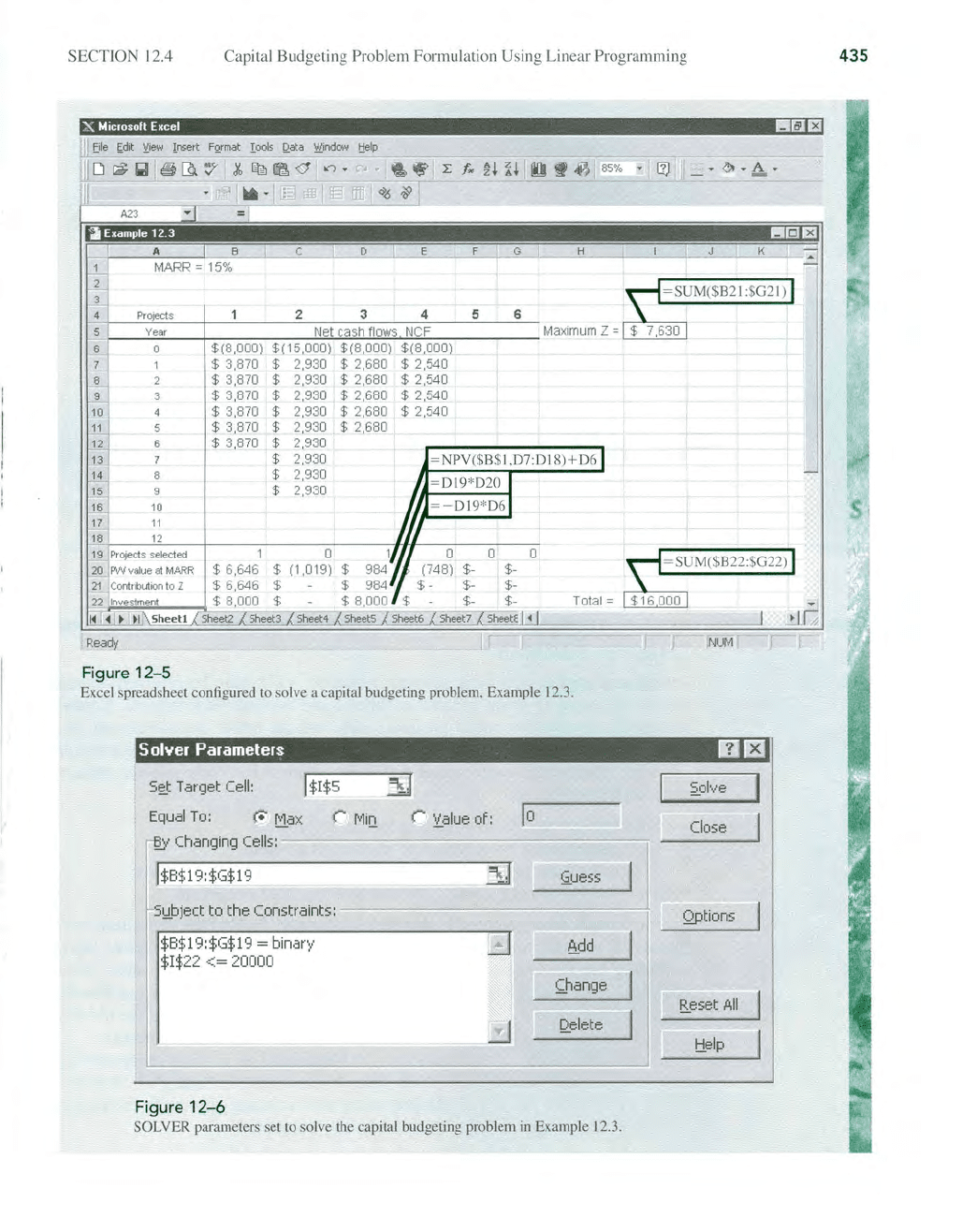
SECTION 12.4
Ca
pital Bu
dget
ing Problem
Form
ulation Using
Linear
Programming
X
Mi
cr
os
oft
EKeel
I!II§I
f3
Eile
~
di
t
~je
w
in
sert
FQ.rmat
I
oo
ls
~ata
~indo\N
tielp
A23
iI
E Hample
12
.3
I!lOO
f3
A
Project
s
Year
1
2
3
.
1~
I?
1§
10
17
11
18 12
19
Projects selected
20
f'VV
value
at
MARR
21
Contribution to Z
22
Inves1ment
I~
~
~
~I
She
etl
Ready
Figure
12-5
$(8
,000)
$ 3,870
$ 3,870
$
3,870
$ 3,870
$ 3,870
$
3,870
2 3 4 5 6
Net cash flows
NCF
$(15,000)
$(8,000) $(8,000)
$ 2,930 $ 2,680 $ 2,540
$ 2,930 $ 2,680 $ 2,540
$ 2,930 $ 2,680 $
2,540
$ 2,930 $ 2,680 $ 2,540
$ 2,930 $ 2,680
$ 2,930
$ 2,930
$ 2,930
$ 2,930
o o
$ (1,019)
$
$ 984 $- $-
$ 984
$-
$-
$ $ 8,000 $- $-
o
~lihilitI
'
l
Total =
Excel spreadsheet co
nfi
gured to solve a capital
bu
dget
in
g pro
bl
em, Example 12.3.
=SUM($B22:$G22)
NUM
5 olver Parameters
DEI
s~
Target
Cell:
J$I$5
spl
ve
Equal
To:
r.
f:1a
x
r
rv1io.
r
~
alue
of:
]0
Close
j'
Changing
Cells:
------.,..-----,-~"'---'~
......
----
........
~-;-
--~
~--'
I I
. 3ij'
§.ue
ss
5!,lbject
to the Constraints:
~-=-~--~
~~
"=''''''''--
..........
-''''"'~~.
$8$19:$(;'$19 = binary
$I$22 <=
20000
Figure
12-6
8.dd
~hange
Q.elete
SOLVER parameters set to solve
th
e ca
pi
tal budgeting pro
bl
em
in
Example 12.3.
Qptions
&eset
All
tielp
435
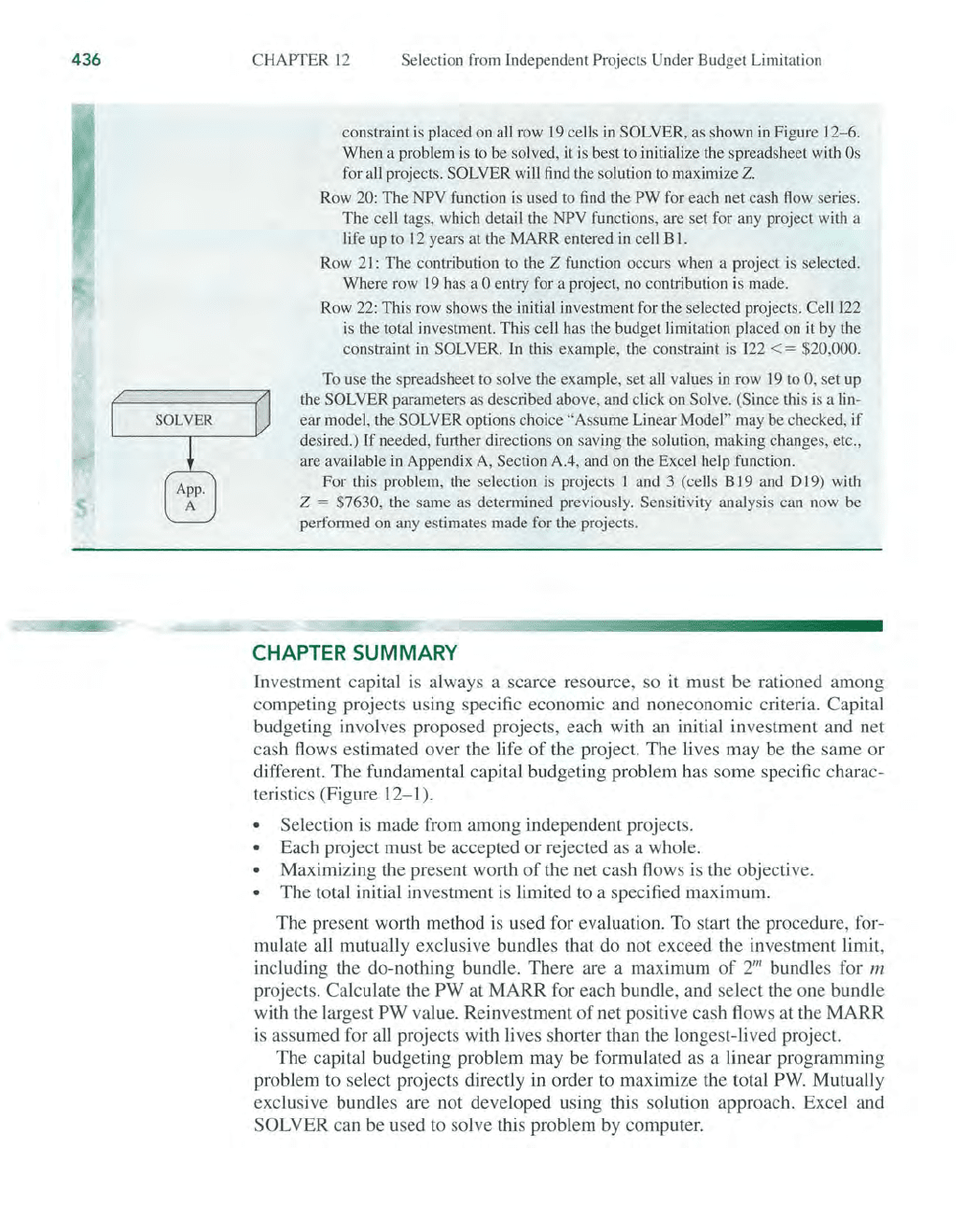
436
CHAPTER
12
Selection from Independent Projects Under Budget Limitation
constraint
is
placed
on
all row
19
cells
in
SOLVER, as shown in Figure 12-6.
When a problem is to be solved,
it
is
best to initialize the spreadsheet with
Os
for all projects. SOLVER will find the solution
to
maximize
Z.
Row 20: The NPV fWlction is used to find the PW for each net cash flow selies.
The cell tags, which detail the NPV functions, are set for any project with a
life
up
to
12
years at the MARR entered in cell
Bl.
Row 21: The contribution to the Z function occurs when a project
is
selected.
Where row
19
has a 0 entry for a project, no contribution is made.
Row
22:
This row shows the initial investment for the selected projects. Cell
122
is
the total investment. This cell has the budget limitation placed on
it
by
the
constraint
in
SOLVER. In this example, the constraint is
122
<=
$20,000.
To
use the spreadsheet to solve the example, set all values
in
row
19
to 0, set up
the
SOLVER parameters as described above, and click on Solve. (Since this
is
a lin-
ear model, the
SOLVER options choice "Assume Linear Model" may be checked,
if
desired.)
If
needed, further directions on saving the solution, making changes, etc.,
are available
in
Appendix
A,
Section A.4, and
on
the Excel help function.
For this problem, the selection
is
projects 1 and 3 (cells B19 and D19) with
Z
= $7630, the same
as
determined previously. Sensitivity analysis can now be
performed on any estimates made for the projects.
CHAPTER
SUMMARY
Investment capital
is
always a scarce resource, so
it
must be rationed among
competing projects using specific economic and noneconomic criteria. Capital
budgeting involves proposed projects, each with
an
initial investment and net
cash flows estimated over the life
of
the project. The lives may be the same or
different. The fundamental capital budgeting problem has some specific charac-
teristics (Figure
12-1).
• Selection is made from among independent projects.
• Each project must be accepted or rejected
as
a whole.
• Maximizing the present worth
of
the net cash flows is the objective.
• The total initial investment
is
limited to a specified maximum.
The present worth method
is
used for evaluation.
To
start the procedure, for-
mulate all mutually exclusive bundles that do not exceed the investment limit,
including the do-nothing bundle. There are a maximum
of
2
m
bundles for m
projects. Calculate the PW at MARR for each bundle, and select the one bundle
with the largest
PW
value. Reinvestment
of
net positive cash flows at the MARR
is
assumed for all projects with lives shorter than the longest-lived project.
The capital budgeting problem may be formulated
as
a linear programming
problem
to
select projects directly in order
to
maximize the total
PW.
Mutually
exclusive bundles are not developed using this solution approach. Excel and
SOLVER can be used
to
solve this problem by computer.
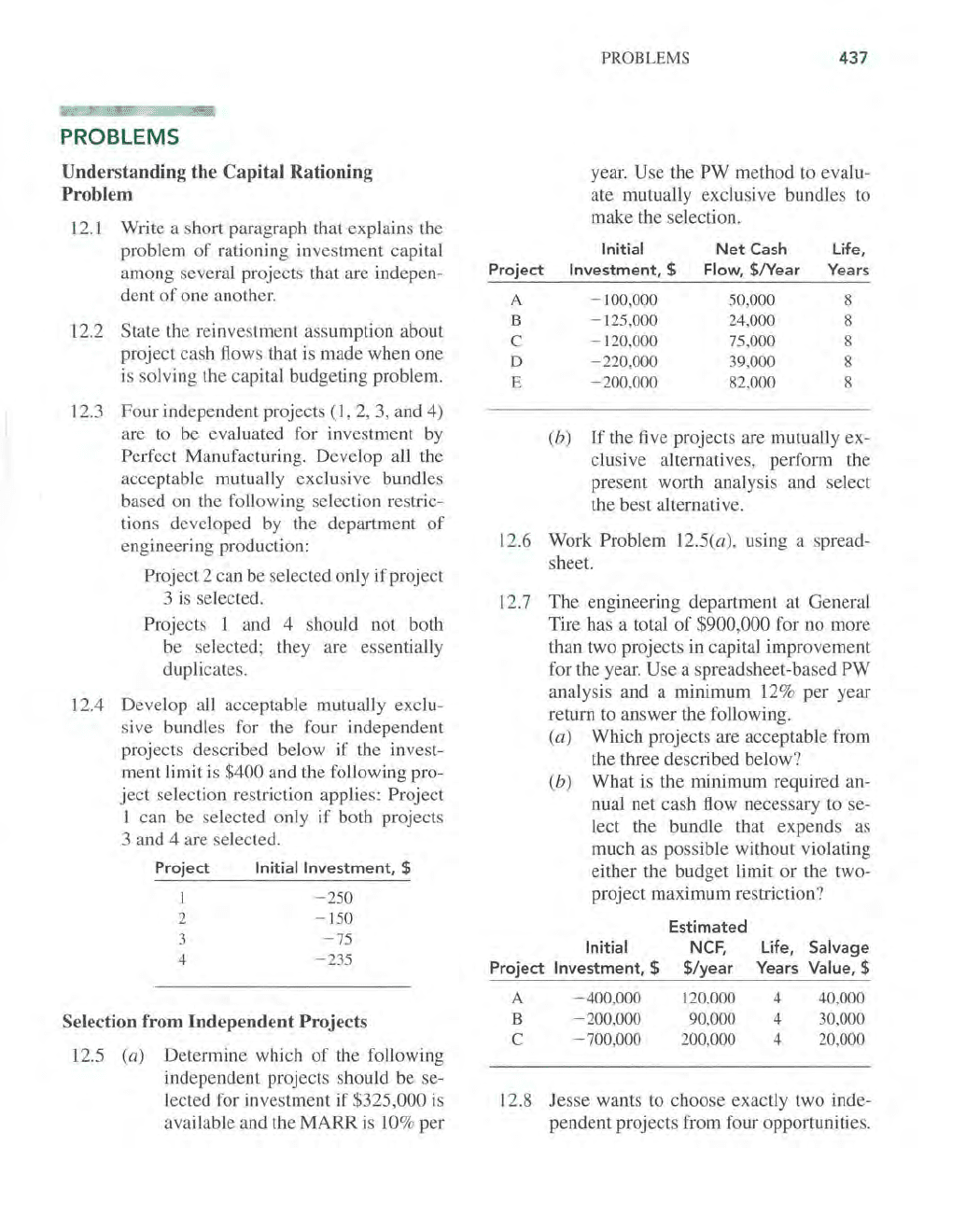
PROBLEMS
Understanding the Capital Rationing
Problem
12.1
Write a short paragraph that explains the
problem
of
rationing investment capital
among several projects that are indepen-
dent
of
one another.
12.2 State the reinvestment assumption about
project cash flows that is made when one
is solving the capital budgeting problem.
12.3
12.4
Four independent projects
(1, 2, 3, and 4)
are to be evaluated for investment by
Perfect Manufacturing. Develop all the
acceptable mutually exclusive bundles
based on the following selection restric-
tions developed by the department
of
engineering production:
Project 2 can be selected only if project
3
is
selected.
Projects 1 and 4 should not both
be selected; they are essentially
duplicates.
Develop all acceptable mutually exclu-
sive bundles for the four independent
projects described below
if
the invest-
ment limit
is
$400 and the following pro-
ject
selection restriction applies: Project
I
can be selected only if both projects
3 and 4 are selected.
Project
2
3
4
Initial Investment, $
- 250
- 150
- 75
- 235
Selection from
Independent
Projects
12.5 (a) Determine which
of
the following
independent projects should be se-
lected for investment
if
$325,000
is
available and the MARR
is
10% per
Project
A
B
C
0
E
PROBLEMS
437
year. Use the
PW
method to evalu-
ate mutually exclusive bundles to
make the selection.
Initial Net Cash
Life,
Investment, $
Flow,
$lYear
Years
- 100,000
50,000
8
-125
,000
24,000
8
-
120
,000
75
,000
8
-220
,000
39,000
8
- 200,000 82,000
8
(b)
If
the five projects are mutually ex-
clusive alternatives, perform the
present worth analysis and select
the best alternative.
12.6 Work
Problem 12.5(a), using a spread-
sheet.
12.7 The engineering department at General
Tire has a total
of
$900,000 for no more
than two projects in capital improvement
for the year.
Use a spreadsheet-based
PW
analysis and a minimum 12% per year
return to answer the following.
Project
A
B
C
(a) Which projects are acceptable from
the three described below?
(b) What is the minimum required an-
nual net cash flow necessary to se-
lect the bundle that expends as
much as possible without violating
either the budget limit or the two-
project maximum restriction?
Estimated
Initial
NCF,
Life,
Salvage
Investment,
$ $/year Years
Value, $
-400,000
120,000 4 40,000
- 200,000 90,000
4 30,000
-700,000
200,000 4 20,000
12.8 Jesse wants to choose exactly two inde-
pendent projects from four opportunities.
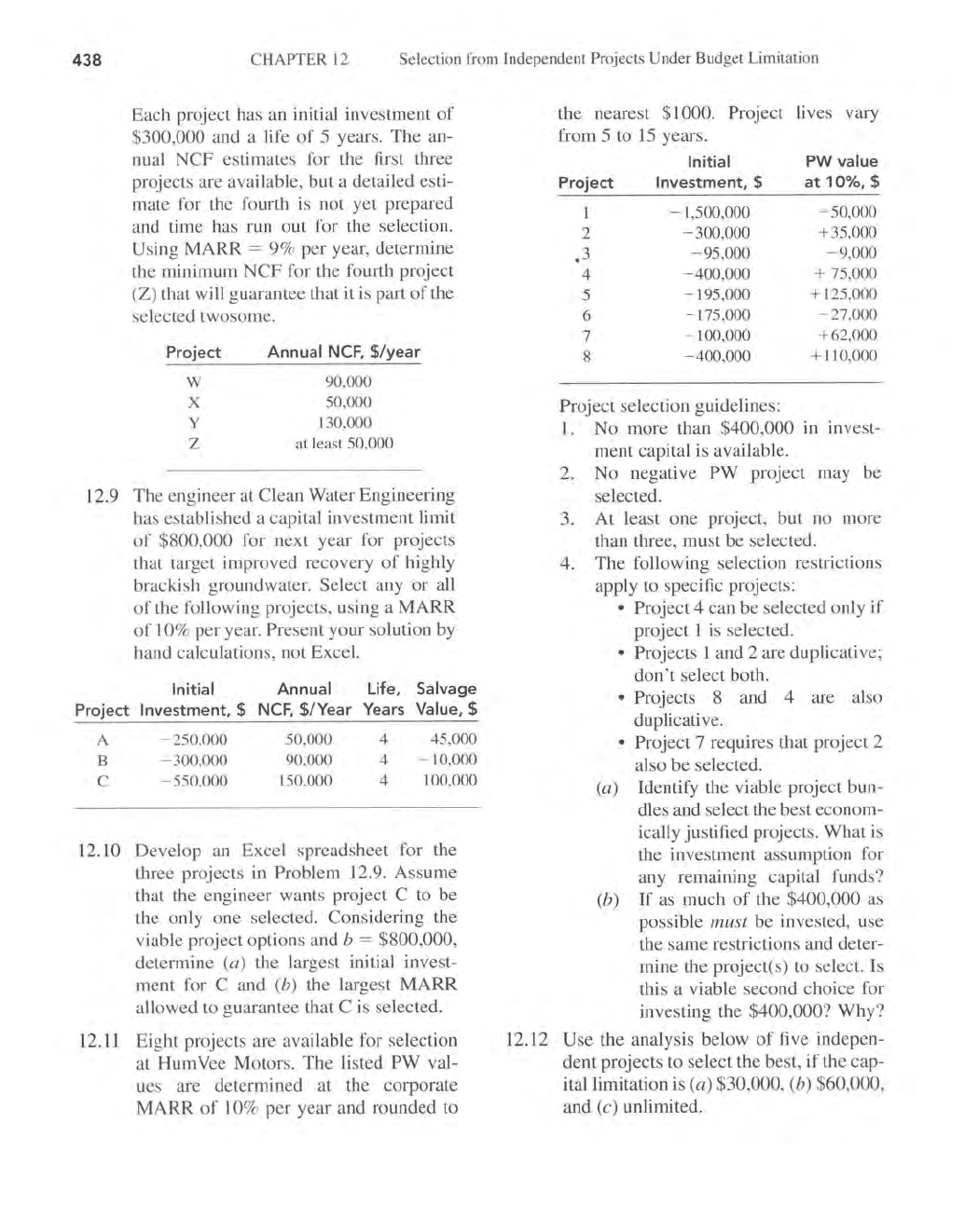
438
CHAPTER
12
Selection from Independent Projects Under Budget Limitation
Each project has an initial investment
of
$300,000 and a life
of
5 years.
The
an-
nual NCF estimates for the first three
projects are available, but a detailed esti-
mate for the fourth
is
not yet prepared
and time has run out for the selection.
Using MARR = 9% per year, determine
the minimum NCF for the fourth project
(Z) that will guarantee that it
is
part
of
the
selected twosome.
Project
w
X
Y
Z
Annual NCF, $/year
90,000
50,000
130,000
at least 50,000
12.9
The
engineer at Clean Water Engineering
has established a capital investment limit
of
$800,000 for next year for projects
that target improved recovery
of
highly
brackish groundwater.
Select any or all
of
the following projects, using a
MARR
of
10
% per year. Present your solution by
hand calculations, not Excel.
Initial Annual
Life,
Salvage
Project Investment, $ NCF, $/Year Years Value, $
A
B
C
- 250,000
- 300,000
- 550,000
50,000
90,000
150
,000
4 45.000
4 - 10,000
4 100,000
12.
10
Develop an Excel spreadsheet for the
three projects
in
Problem 12.9. Assume
that the engineer wants project C to be
the only one selected. Considering the
viable project options and
b = $800,000,
determine (a) the largest initial invest-
ment for C and
(b) the largest
MARR
allowed to guarantee that C
is
selected.
12.
ll
Eight projects are available for selection
at HumVee Motors.
The
listed
PW
val-
ues are determined at the corporate
MARR
of
10
% per year and rounded to
the nearest
$1000. Project
lives vary
from 5 to
15
years.
Initial
PW
value
Project
Investment,
$
at
10%, $
- 1,500,000
- 50,000
2
-300
,000
+35
,000
. 3
-95,000
- 9,000
4
- 400,000 + 75,000
5
-195
,000 +
125
,000
6
-175,000
-27,000
7
-100,000
+62,000
8
-400,000
+ 110,000
Project selection guidelines:
1.
No
more than $400,000 in invest-
ment capital
is
available.
2.
No
negative
PW
project may be
selected.
3.
At
least one project, but no more
than three, must be selected.
4.
The
following selection restrictions
apply to specific projects:
• Project 4 can be selected only if
project 1
is
selected.
• Projects 1 and 2 are duplicative;
don't
select both.
• Projects 8 and 4 are also
duplicative.
• Project 7 requires that project 2
also be selected.
(a) Identify the viable project bun-
dles and select the best econom-
ically justified projects. What
is
the investment assumption for
any remaining capital funds?
(b)
If
as much
of
the $400,000 as
possible
must
be invested, use
the same restrictions and deter-
mine the project(s) to select. Is
this a viable second choice for
investing the
$400,000? Why?
12.12
Use the analysis below
of
five indepen-
dent projects to select the best, if the cap-
itallimitation is
(a) $30,000, (b) $60,000,
and (c) unlimited.

Initial Life, PW
at
12%
Project
Investment,
$
Years
per
Year, $
S
- 15,000
6
8,540
A
- 25,000
8
12,325
M
- 10,000
6 3,000
E
- 25,000
4
10
H
- 40,000
12
15
,350
1
2.
13 The independent project estimates below
have been developed by the engineering
and finance managers. The corporate
MARR
is
15
% per year, and the capital
investment limit is $4 million.
Project
2
3
4
(a) Use the
PW
method and hand solu-
tion to select the economically best
projects.
(b) Use the
PW
method and computer
solution to select the economically
best projects.
Project
Cost,
Life,
NCF,
$ Millions
Years
$lYear
-
1.5
8
360,000
- 3.0
10
600,000
-
1.8
5 520,000
- 2.0
4
820,000
1
2.
14 The following capital rationing problem
is defined. Three projects are to be evalu-
ated at a MARR
of
12.5% per year. No
more than $3.0 million can be invested.
(a) Use a spreadsheet to select from the
independent projects.
(b) Use SOLVER to determine the
minimum year 1 NCF for project
3 alone to have the same PW as the
best bundle in part (a)
if
project 3
life can be increased to 10 years for
the same
$1
million investment. All
other estimates remain the same.
With this increased NCF and life,
what are the best projects for in-
vestment?
PROBLEMS
439
Estimated
NCF,
$/Year
Investment,
Life,
Gradient
Project
$ Millions Years
Year 1
after
Year 1
-0.9
6
250,000 - 5000
2 -
2.1
10
485,000
+5000
3
-
1.0
5 200,000 +
10
%
1
2.
15
Use the PW method to evaluate four in-
dependent projects. Select as many as
three
of
the four projects. The MARR
is
12
% per year, and an available capital
investment limit is $16,000.
Project
1 2
3 4
Investment,
$
- 5000
-8000
- 9000 - 10,000
Life,
years
5 5 3
4
Year NCF
Estimates,
$
1
1000
500 5000
0
2 1700
500 5000
0
3 2400
500
2000
0
4
3000
500
17,000
5 3800 10,500
12
.
16
Work Problem 12.15, using a spreadsheet.
1
2.
17
Using the NCF estimates
in
Problem
12.15 for projects 3 and 4, demonstrate
the reinvestment assumption made when
the capital budgeting problem is solved
for the four projects by using the
PW
method. (Hint: Refer to Equation [12.2].)
Linear Programming
and
Capital Budgeting
12
.18 Formulate the linear programming model,
develop a spreadsheet, and solve the
capital rationing problem in Example
12.1
(a) as presented and (b) using
an
investment limit
of
$13 million.
12
.
19
For Problem 12.5, use Excel and
SOLVER to (a) answer the question
in
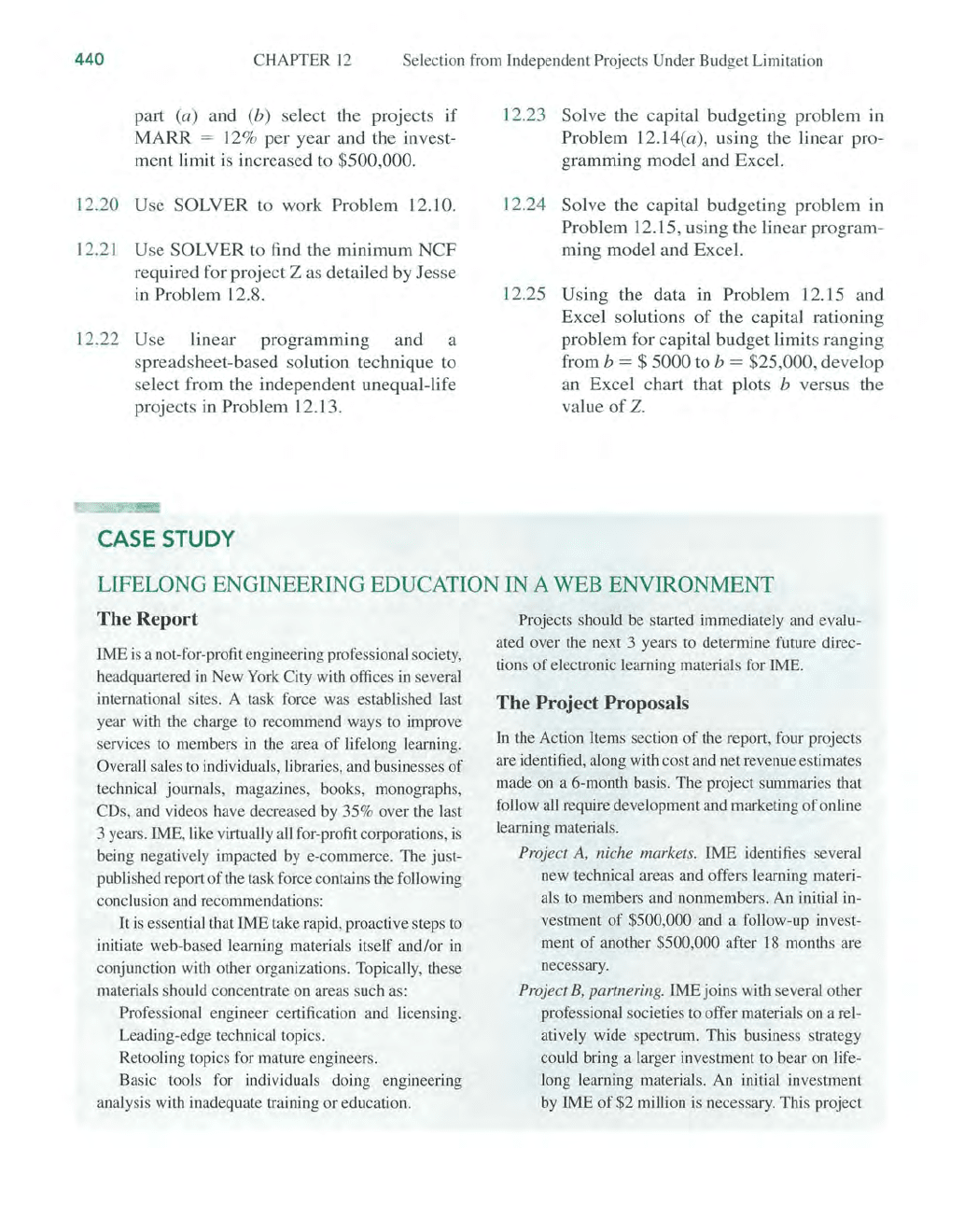
440
CHAPTER
12
Selection from Independent Projects Under Budget Limitation
part (a) and (b) select the projects
if
MARR = 12% per year and the invest-
ment limit
is
increased
to
$500,000.
12
.20 Use SOLVER
to
work Problem 12.10.
12.21
Use SOLVER
to
find the minimum NCF
required for project Z
as
detailed
by
Jesse
in
Problem 12.8.
12.22
Use linear programmjng and a
spreadsheet-based solution technique
to
select from the independent unequal-life
projects
in
Problem 12.13.
CASE STUDY
12.23 Solve the capital budgeting problem
in
Problem 12.14(a), using the linear pro-
gramming model and Excel.
12
.24 Solve the capital budgeting problem
in
Problem 12.15, using the ljnear program-
mjng model and Excel.
12.25
Using the data in Problem 12.15 and
Excel solutions
of
the capital rationing
problem for capital budget limjts ranging
from b = $ 5000
to
b = $25,000, develop
an Excel chart that plots
b versus the
value
of
Z.
LIFELONG ENGINEERING EDUCATION IN A WEB ENVIRONMENT
The Report
IME
is
a not-for-profit engineer
in
g professional society,
headquartered
in
New York City with offices in several
international sites. A task force was established last
year with the charge to recommend ways to improve
services to members
in
the area
of
lifelong learning.
Overall sales
to
individuals, libraries, a
nd
businesses
of
technical journals, magazines, books, monographs,
CDs, and videos have decreased by 35% over the last
3 years. IME,
li
ke virtually a
ll
for-profit corporations,
is
being negatively impacted bye-commerce. The just-
published repOlt
of
the task force contains the following
conclusion and recommendations:
It
is
essential that IME take rapid, proactive steps to
initiate web-based learning materials itself and/or in
conjunction with other organizations. Topically, these
materials should concentrate on areas such as:
Professional engineer certification and licensing.
Leading-edge technical topics.
Retooling topics for mature engineers.
Basic tools for individuals doing engineering
ana
ly
sis with
in
adequate training
or
education.
Projects should be started immediately and evalu-
ated over the next 3 years to determine future direc-
tions
of
electronic learning materials for IME.
The Project Proposals
In
the Action Items section
of
the report, four projects
are identified, along with cost and net revenue estimates
made on a 6-month basis. The project summaries that
follow all require development and marketing
of
online
learning materials.
Project
A,
niche markets.
!ME
identifies several
new technical areas and offers Ieanling materi-
als to members and nonmembers.
An
initial in-
vestment
of
$500,000 and a follow-up invest-
ment
of
another $500,000 after
18
months are
necessary.
Project B, partnering. IME joins with several other
professional societies to offer materials on a rel-
atively wide spectrum. This business strategy
could bring a larger investment to bear on life-
long learning materials.
An
initial investment
by
IME
of
$2 million is necessary. This project
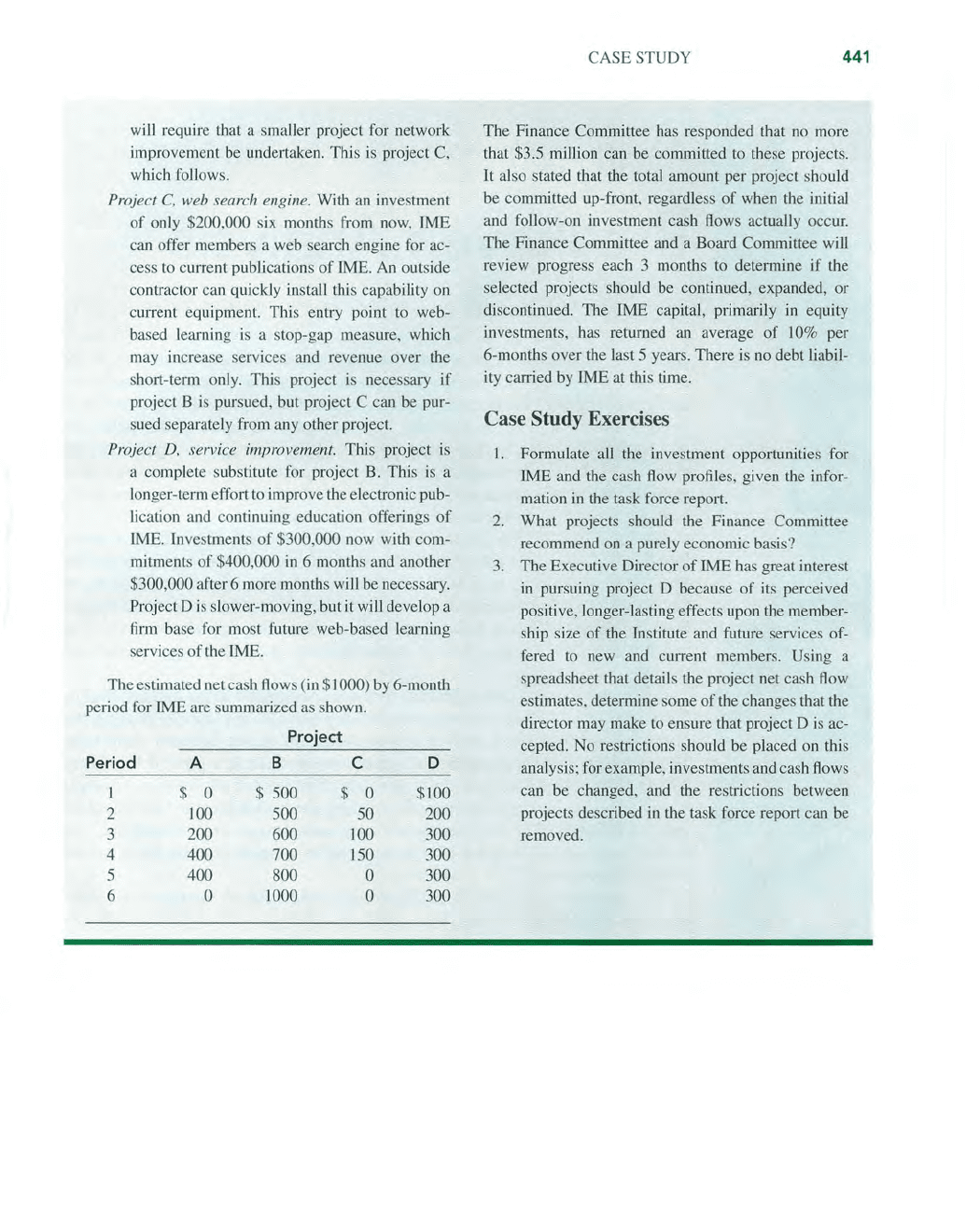
will require that a smaller project for network
improvement
be
undertaken. This
is
project C,
which foHows.
Project C, web search engin
e.
With
an
in
vestment
of
only $200,000 six months from now, 1ME
can offer me
mb
ers a web search engine for ac-
cess
to
current publications
of
IME.
An
outside
contractor can qui
ck
ly
install this capability on
current equipment. This entry point to web-
based learn
in
g is a stop-gap measure, which
may
in
crease services a
nd
revenue over the
short-term only. This project is necessary if
project B is pursued, but project C can be pur-
sued separately from any other project.
Project
D,
service improvement. This project
is
a complete substitute for project B. This
is
a
longer-term effort to improve
th
e electronic pub-
li
cation and continuing education offerings
of
lME. Investments
of
$300,000 now with com-
mitments
of
$400,000
in
6 months and another
$300,000 after 6 more months will be necessary.
Project D
is
slower-moving, but it will develop a
firm
base for most future web-based learning
services
of
the IME.
The estimated net cash flows (in $1
000) by 6-month
period for IME are summarized
as
s
ho
wn.
Project
Period
A B
C
0
$
0
$ 500
$ 0 $100
2
100 500 50 200
3 200 600 100 300
4 400 700 150
300
5 400
800 0 300
6 0 1000 0 300
CASE STUDY
441
The Finance Committee has responded that no more
that $3.5 million can be committed to these projects.
It also stated that the total amount per project should
be committed up-front, regardless
of
when the
in
itial
and follow-on investment cash flows actually occ
ur.
The Finance Committee and a Board Committ
ee
will
review progress each 3 months to determine
if
the
selected projects should be continued, expanded,
or
discontinued. The 1ME capital, primarily in equity
investments, has returned
an
average
of
10% per
6-months over the last 5 years. There is
no
debt liabil-
ity carried by 1ME at this time.
Case Study Exercises
1.
Formulate all the investment opportunities for
1ME and the cash flow profiles, given the infor-
mation
in
the task force report.
2. What projec
ts
should the Finance Committee
recommend on a purely economic basis?
3.
The Executive Director
of
1ME has great interest
in pursuing project D because
of
its perceived
positive, longer-lasting effects upon the member-
ship size
of
the Institute and future services of-
fered to new and current members.
Using a
spreadsheet that details the project net cash flow
estimates, determine some
of
the changes that the
director may make to ensure that project D is ac-
cepted. No restrictions should be placed on this
analysis; for example, investments and cash flows
can be changed, and the restrictions b
et
ween
projects described
in
the task force report can be
removed.
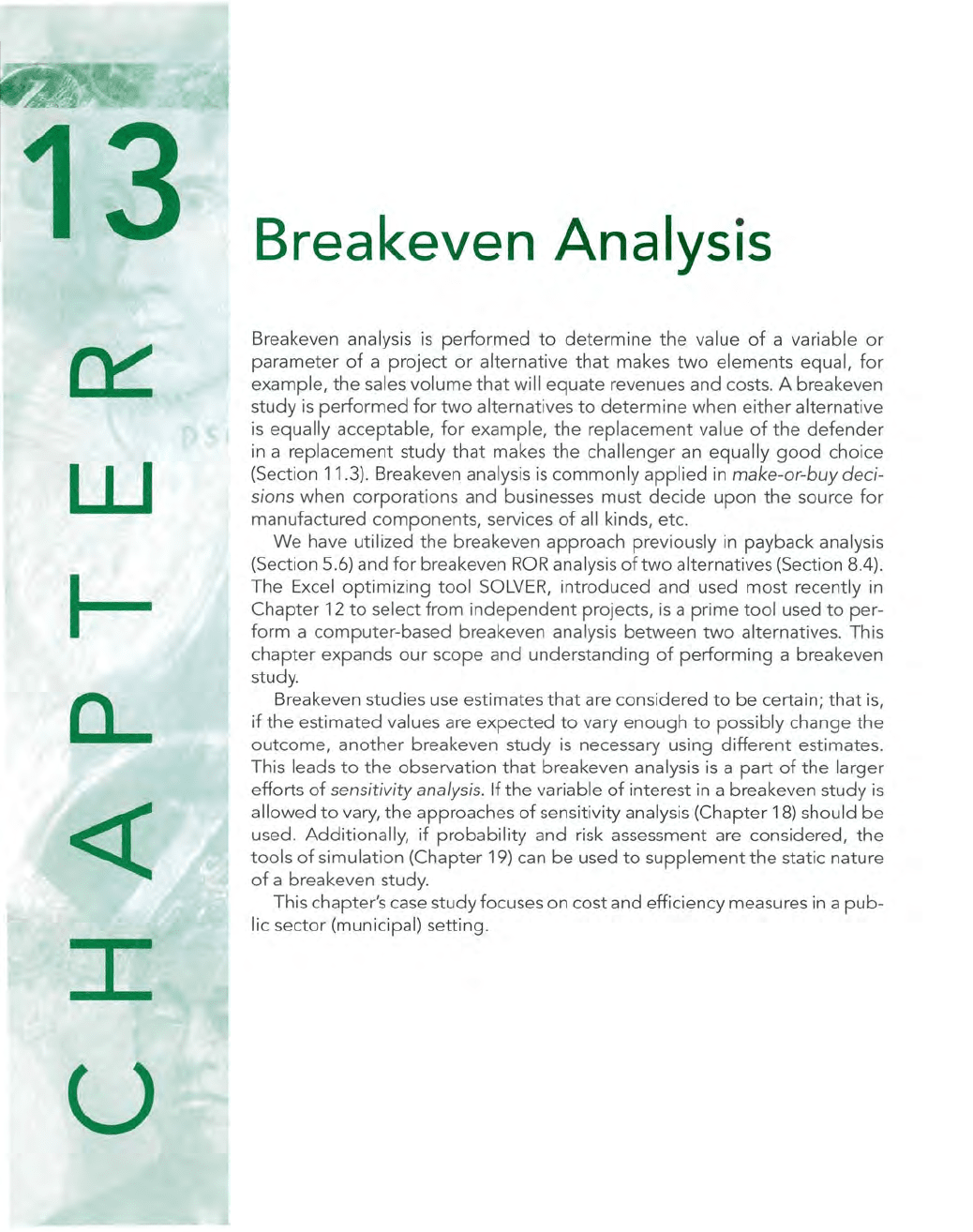
1
UJ
I-
I
u
Breakeven Analysis
Breakeven analysis
is
performed
to
determine
the
value
of
a variable
or
parameter
of
a
project
or
alternative
that
makes
two
elements
equal,
for
example,
the
sales
volume
that
will
equate
revenues
and
costs. A breakeven
study
is
performed
for
two
alternatives
to
determine
when
either
alternative
is
equally
acceptable,
for
example,
the
replacement
value
of
the
defender
in
a
replacement
study
that
makes
the
challenger
an
equally
good
choice
(Section
11
.
3).
Breakeven analysis
is
commonly
applied
in make-or-buy deci-
sions
when
corporations
and
businesses
must
decide
upon
the
source
for
manufactured
components,
services
of
all kinds,
etc
.
We
have
utilized
the
breakeven
approach
previously in
payback
analysis
(Section 5.6)
and
for
breakeven
ROR
analysis
oftwo
alternatives (Section 8.4).
The
Excel
optimizing
tool
SOLVER,
introduced
and
used
most
recently
in
Chapter
12
to
select
from
independent
projects,
is
a
prime
tool
used
to
per-
form
a
compute
r-based breakeven analysis
between
two
alternatives. This
chapter
expands
our
scope
and
understanding
of
performing
a breakeven
study
.
Breakeven studies use estimates
that
are
considered
to
be
certain;
that
is
,
if
the
estimated
values are
expected
to
vary
enough
to
possibly
change
the
outcome
,
another
breakeven
study
is
necessary using
different
estimates.
This
leads
to
the
observation
that
breakeven analysis
is
a
part
of
the
larger
efforts
of
sensitivity analysis.
If
the
variable
of
interest
in a breakeven
study
is
allowed
to
vary,
the
approaches
of
sensitivity analysis
(Chapter
18)
should
be
used.
Additionally,
if
probability
and
risk assessment are
considered,
the
tools
of
sim
ulation
(Chapter
19) can
be
used
to
supplement
the
static
nature
of
a breakeven
study
.
This chapter's case
study
focuses
on
cost
and
efficiency measures in a
pub-
lic
sector
(municipal)
setting
.
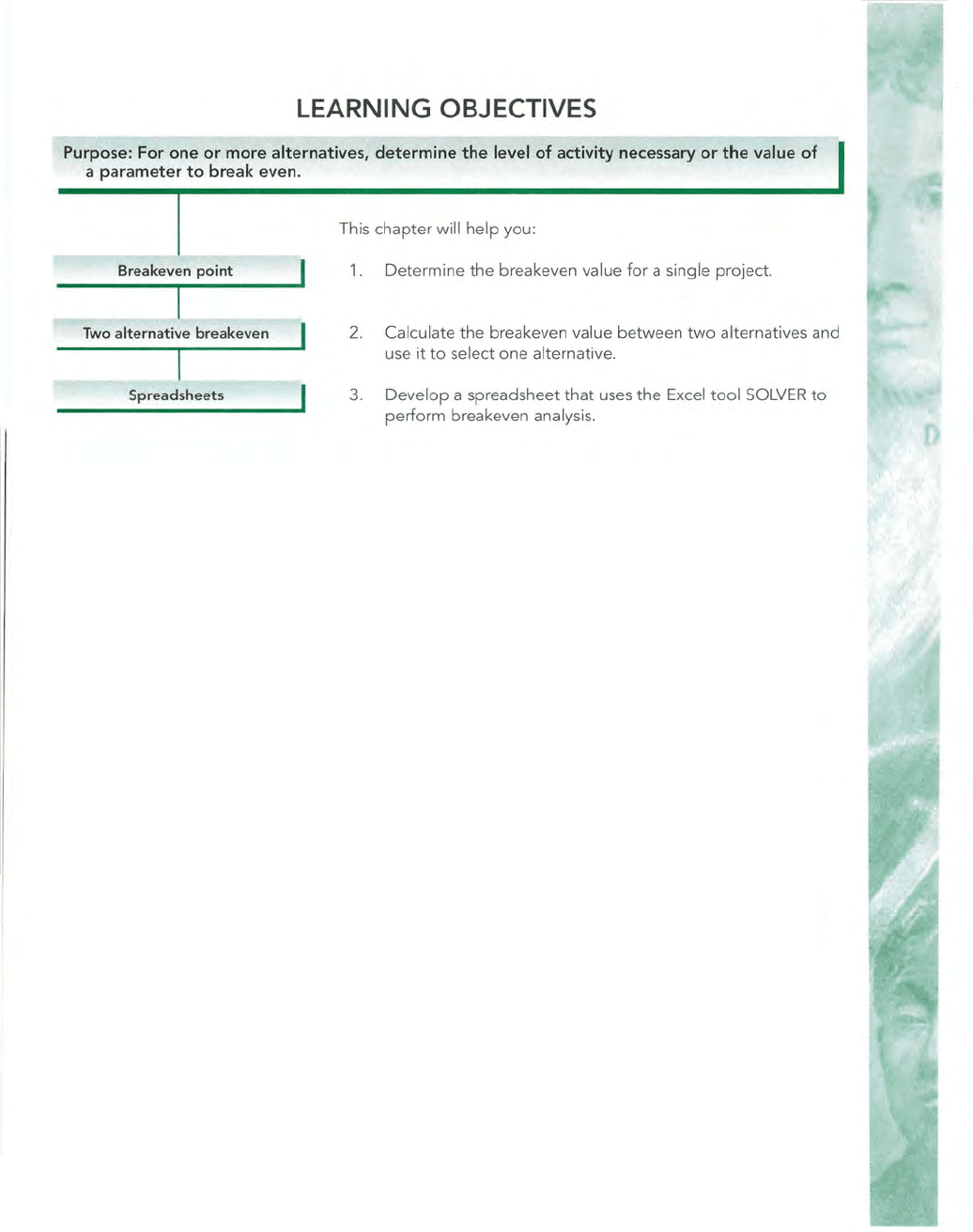
LEARNING OBJECTIVES
Purpose: For one or more alternatives, determine the level
of
activity necessary
or
the
value
of
a parameter
to
break even.
Breakeven
point
Two alternative breakeven
Spreadsheets
This
chapter
will
help
you:
1.
Determine
the
breakeven value
for
a single
project
.
2.
Calculate
the
breakeven value
between
two
alternatives and
use
it
to
select
one
alternat
ive.
3.
Develop
a
spreadsheet
that
uses
the
Excel
tool
SOLVER
to
perform
breakeven analysis.
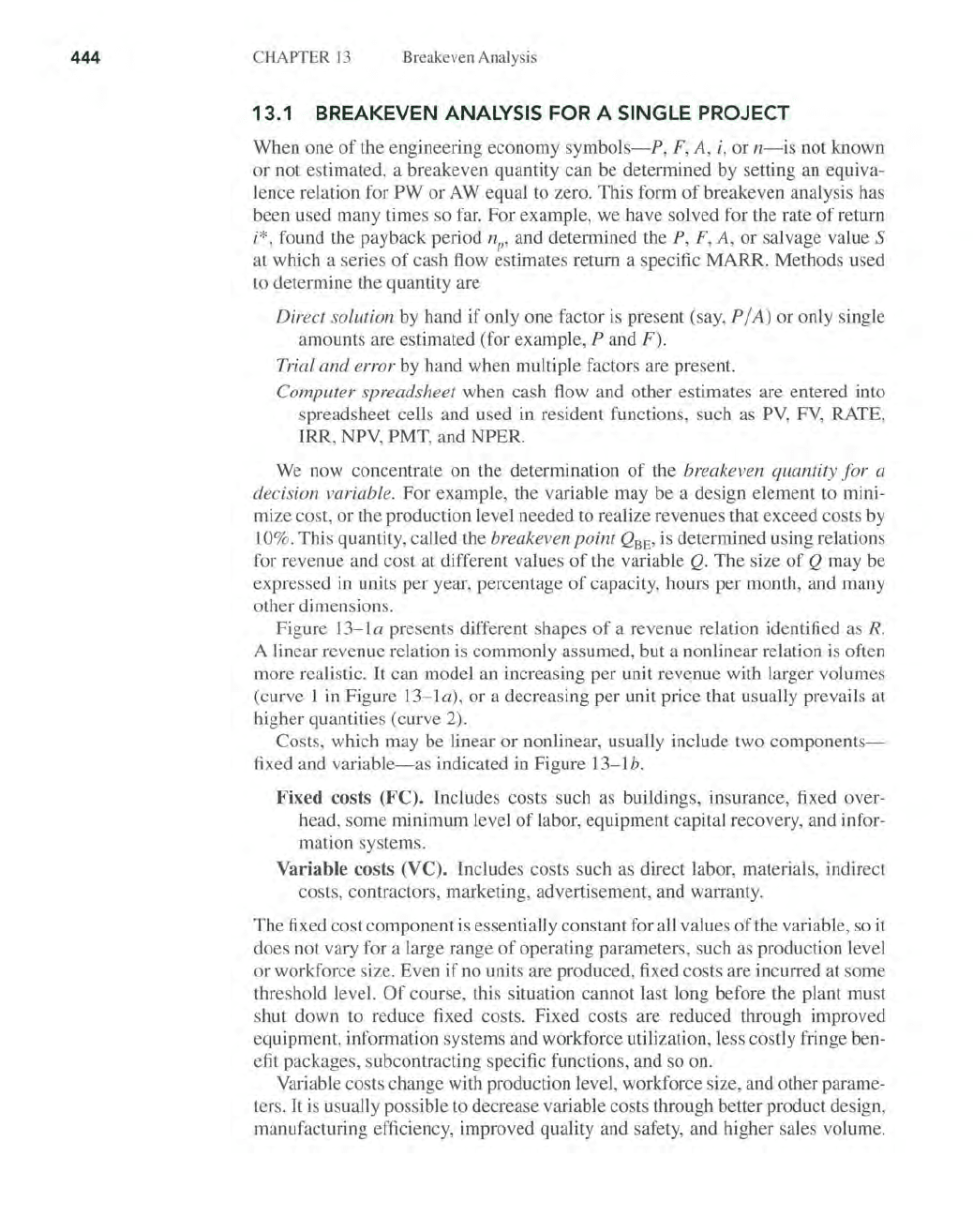
444
CHAPTER
13
Breakeven Analysis
13.1 BREAKEVEN ANALYSIS FOR A SINGLE PROJECT
When one
of
the engineering economy
symbols-P,
F, A,
i,
or
n-is
not known
or not estimated, a breakeven quantity can be determined by setting an equiva-
lence relation for
PW
or
AW
equal to zero. This form
of
breakeven analysis has
been used many times so far. For example, we have solved for the rate
of
return
i*, found the payback period nfl' and determined the P, F, A, or salvage value S
at which a series
of
cash flow estimates return a specific MARR. Methods used
to determine the quantity are
Direct solution by hand
if
only one factor is present (say, P / A)
or
only single
amounts are estimated (for example,
P and
F)
.
Trial and error by hand when multiple factors are present.
Computer spreadsheet when cash flow and other estimates are entered into
spreadsheet cells and used in resident functions, such as
PV,
FV,
RATE,
IRR,
NPV, PMT, and NPER.
We
now concentrate on the determination
of
the breakeven quantity
for
a
decision variable. For example, the variable may be a design element to mini-
mize cost, or the production level needed to realize revenues that exceed costs by
10
%.
This quantity, called the breakeven point
QB
E'
is determined using relations
for revenue and cost at different values
of
the variable
Q.
The size
of
Q may be
expressed
in
units per year, percentage
of
capacity, hours per month, and many
other dimensions.
Figure
13-1a
presents different shapes
of
a revenue relation identified as
R.
A linear revenue relation
is
commonly assumed, but a nonlinear relation
is
often
more realistic. It can model an increasing per unit revenue with larger volumes
(curve J
in
Figure
13-la)
, or a decreasing per unit price that usually prevails at
higher quantities (curve 2).
Costs, which may be linear or nonlinear, usually include two
components-
fixed and
variable-as
indicated in Figure 13-1b.
Fixed costs (FC). Includes costs such as buildings, insurance, fixed over-
head, some minimum level
of
labor, equipment capital recovery, and infor-
mation systems.
Variable costs
(Ve).
Includes costs such as direct labor, materials, indirect
costs, contractors, marketing, advertisement, and warranty.
The fixed cost component is essentially constant for all values
of
the variable, so it
does not vary for a large range
of
operating parameters, such as production level
or workforce size. Even
if
no units are produced, fixed costs are incurred at some
threshold level.
Of
course, this situation cannot last long before the plant must
shut down to reduce fixed costs. Fixed costs are reduced through improved
equipment, information systems and workforce utilization, less costly fringe ben-
efit packages, subcontracting specific functions, and so on.
Variable costs change with production level, workforce size, and other parame-
ters. It is usually possible to decrease variable costs through better product design,
manufacturing efficiency, improved quality and safety, and higher sales volume.
